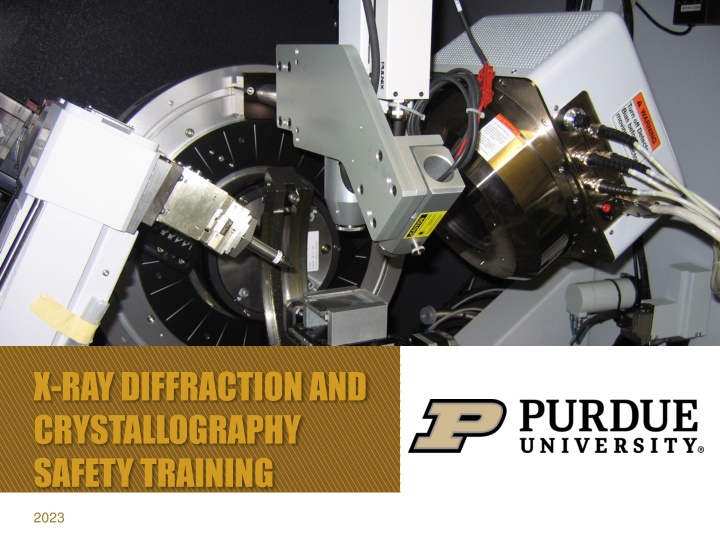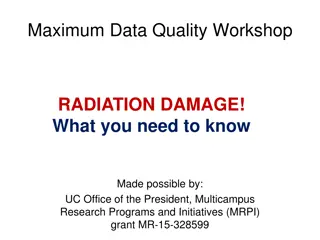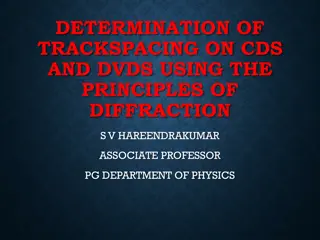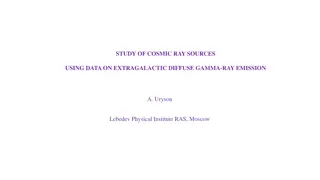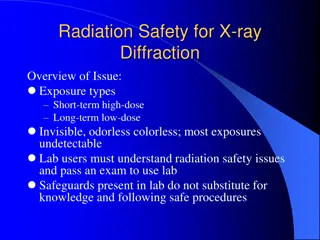X-ray Diffraction and Crystallography Safety Training Overview
X-ray diffraction and crystallography involve the use of ionizing electromagnetic radiation, specifically X-rays, which pose health risks if not handled properly. This training covers principles of X-ray safety, the importance of shielding materials like lead, steel, and concrete, X-ray production mechanisms, biological effects of radiation exposure, dose limits, and radiation safety principles. Understanding these concepts is crucial for minimizing risks associated with X-ray experiments and ensuring a safe working environment.
Download Presentation

Please find below an Image/Link to download the presentation.
The content on the website is provided AS IS for your information and personal use only. It may not be sold, licensed, or shared on other websites without obtaining consent from the author.If you encounter any issues during the download, it is possible that the publisher has removed the file from their server.
You are allowed to download the files provided on this website for personal or commercial use, subject to the condition that they are used lawfully. All files are the property of their respective owners.
The content on the website is provided AS IS for your information and personal use only. It may not be sold, licensed, or shared on other websites without obtaining consent from the author.
E N D
Presentation Transcript
X-RAY DIFFRACTION AND CRYSTALLOGRAPHY SAFETY TRAINING 2023
X-RAYS X-rays are a type of ionizing electromagnetic radiation. X-rays are a valuable tool, but there are associated health risks. These risks can be minimized by adhering to certain principles and practices as explained in this presentation. Diffraction experiments typically use soft X-rays which are less dangerous than the hard X-rays used in medicine. X-rays are capable of traveling great distances and penetrating through low- density materials such as wood and plastic. However, they can be blocked or attenuated by shielding made from high- density materials such as lead and concrete.
X-RAY SHIELDING While all materials absorb X-rays, dense materials such as lead, steel and concrete are the most effective. Hence, they are the preferred shielding materials.
X-RAY PRODUCTION (1) X-ray are generated in the X-ray tube of the device. Electrons, that have been accelerated using a high voltage source, are abruptly decelerated by striking a metal target (e.g., copper, molybdenum, and tungsten). Some of the energy of the electrons that impinge upon the target are converted into X-rays.
X-RAY PRODUCTION (2) X-ray production is proportional to operating potential (kVp) and current (mA) When the X-ray unit is not operating or it is powered down, the high voltage is not applied and X-rays are not produced. Therefore, there is no danger present when the machine is not operating or it is powered down. For certain X-ray diffraction units, it is recommended that diffraction units idle at low power instead of powering down
BIOLOGICAL EFFECTS, DOSE LIMITS AND RADIATION SAFETY PRINCIPLES
DOSE When radiation interacts with living material such as our bodies, they may deposit enough energy to cause biological damage. Biological damage can occur as a result of chemical bonds being broken, DNA damage, and cells being damaged or killed. Radiation induced health effects are dependent on radiation dose. The rem is the common unit of dose in the U.S. o 1 rem = 1000 millirem (mrem) The sievert is the common international unit of dose. o 1 sievert = 100 rem
HEALTH EFFECTS OF RADIATION EXPOSURE Health Effects from exposure to radiation range from no effect at all to death, including diseases such as cancer. The health effects can be divided into two categories: 1. Early Effects 2. Delayed Effects
EARLY EFFECTS (1) Occur shortly after exposures resulting in large doses (>100 rem), delivered within a short time period (acute exposure) Acute exposures cause extensive biological damage to cells so that large numbers of cells are killed. The severity of the health effects is proportional to the dose. Possible health effects include: vomiting, diarrhea, skin burns, cataracts, hair loss, fever, lethargy, loss of appetite, changes in blood count, and death.
EARLY EFFECTS (2) An estimated dose of around 325 rem for young healthy adults without medical intervention will result in death to 50% of the group within 60 days. For a dose of less than about 800 rem, an exposed person is likely to survive with appropriate hospital care. Under normal operation, the occurrence of early effects is highly unlikely.
DELAYED EFFECTS Occur years after acute and chronic (low doses over a long time period) exposures. Possible health effects include: leukemia, cancer, life span shortening, cataracts, and genetic defects.
DELAYED EFFECTS - GENETIC EFFECTS Radiation studies involving fruit flies and mice suggest the possibility of heritable genetic effects in humans if there is radiation damage to the cells of the sperm or eggs. These effects may show up as genetic defects in the children of exposed individuals and succeeding generations. Scientists have studied populations of individuals exposed to radiation (e.g., atomic bomb survivors and radiation workers) to identify the presence of heritable genetic effects. To date, no heritable genetic effects from radiation have ever been observed in any human population exposed to doses ranging from natural background to that received by atomic bomb survivors.
DELAYED EFFECTS STOCHASTIC Leukemia, cancer, and genetic effects are considered stochastic effects; the probability of occurrence is dependent of dose. As dose increases, the probability of occurrence increases. Conservative studies estimate a 0.04% increase of developing an adverse health effect per rem received. For additional information, refer to Regulatory Guide 8.29
GOVERNMENT DOSE LIMITS In an effort to reduce the risk of potential health effects caused by radiation, the Indiana State Department of Health (ISDH) has set dose limits for those working with radiation producing devices. These limits are put in place to create an upper limit of how much radiation a worker is allowed to be exposed to within a certain time period. Individuals who stay below the dose limits: Will not develop any early effects. Will maintain a very small risk of developing delayed effects. 14
DOSE LIMIT VALUES The ISDH has permitted Purdue University to use Nuclear Regulatory Commission (NRC) dose limits. NRC Dose Limits (10 CFR 20.1201) Section of Body Limit (rem) Whole Body (Head, torso and organs) 5 Lens of the Eye 15 50 Extremities (Hands, forearms, feet and ankles) 15
RADIATION & PREGNANCY (1) Epidemiological studies of the A-bomb survivors, pregnant women who received pelvic X-rays, and animal studies indicate that embryos and fetuses are extremely radiosensitive. The principal effects of radiation on the developing embryo and fetus, are embryonic, fetal, or neonatal death; congenital malformations; growth retardation; and functional impairment, such as mental retardation; and cancer. The effects depend on the stage of gestation, the dose, and the dose rate. These occurrences are extremely unlikely at Purdue because the doses possible from normal operation are very low.
RADIATION & PREGNANCY (2) Pregnant individuals should take all precautions possible to keep exposures to the embryo or fetus as low as possible. Extra precautions are taken by Purdue University for a Declared pregnant woman. Declared pregnant woman means a woman who has voluntarily informed Purdue, in writing, of her pregnancy and the estimated date of conception. If a declaration is made, it must be given to the Radiation Safety Officer (RSO) in writing.
RADIATION & PREGNANCY (3) Once in effect, the pregnant worker s exposure limit will be reduced to 10% of the occupational dose limit. In addition, that worker will be given a fetal dosimeter to monitor the dose received by the embryo or fetus. The declaration remains in effect until the declared pregnant woman withdraws the declaration in writing or is no longer pregnant. For additional information, refer to Regulatory Guide 8.13 18
ALARA The risk of developing delayed effects can be decreased by decreasing dose. Scientists accept the linear no-threshold theory which states that even low-doses carry some risk of developing delayed effects. The goal is not only to remain below the dose limits, but to keep it even lower by trying to keep doses As Low As Reasonably Achievable (ALARA). ALARA is not just a good idea, it is REQUIRED by law (410 IAC 5 Rule 4).
ALARA PRINCIPLES There are several practices that will help you to keep your dose As Low As Reasonably Achievable (ALARA). Time: Decreasing the time spent in a radiation area results in a lower accumulated dose. Plan work efficiently to avoid spending too much time near X-ray equipment. Distance: The greater the distance between you and the X-ray unit, the lower the dose. Shielding: The greater the shielding, the lower the dose. Lead and concrete works well to attenuate X-rays.
DOSIMETRY (1) Dosimetry Device worn by radiation users to measure their accumulated dose. It is used to ensure that you do not exceed the government- established dose limits. There are two types: 1. Ring measures dose to the hands, worn on the hand receiving the highest dose with name facing the palm side 2. Whole-body measures dose to the torso and head, worn on the part of the torso that will receive the highest dose
DOSIMETRY (2) If issued dosimetry, you MUST wear it every time you are operating X-ray equipment Dosimetry must be returned at the end of the wear period (monthly or bimonthly), to be analyzed. Dose measurement may be lost if dosimeter is returned late Lost dosimetry may result in a monetary fine
X-RAY DEVICE SAFETY FEATURES, EXPOSURE PATHWAYS, AND SAFE PRACTICES
SAFETY FEATURES CABINET Cabinet The device contains a cabinet which absorbs a significant fraction of low- energy X-rays that would otherwise escape. The cabinet also prevents parts of the body from entering the primary X-ray beam.
SAFETY FEATURES WINDOWS Windows The device contains windows (e.g., Plexiglass or leaded glass) which absorb a significant fraction of the low- energy X-rays while allowing the user to view the procedure.
SAFETY FEATURES INTERLOCK Interlock The device contains a mechanical switch that doesn t allow X-rays to be produced when the shielded cabinet door(s) is open. X-rays will be produced when the door(s) is shut.
SAFETY FEATURES HOUSING AND SHUTTER X-ray Tube Housing and Beam Shutter The X-ray tube is enclosed in a shielded housing (upper right). The beam shutter (bottom right) allows the useful beam of X-rays to escape. When the beam shutter is closed, X-rays are contained within the housing. Some devices allow users to close the beam shutter while X-rays are still produced. This facilitates safe and convenient sample changes/manipulations.
SAFETY FEATURES WARNING LIGHTS Warning Light Indicates that X-rays are being produced. Units with beam shutters also have a warning light indicating whether the shutter is open or closed. These are failsafe, meaning X-rays will not be produced if the light is not operational (i.e., If the light is burnt out, X-rays will not be generated). The warning light are usually located on the control panel and/or shielded cabinet. 28
SAFETY FEATURES BEAM STOP Beam Stop The useful X-ray beam exits a collimator and is quite small (approximately 1 millimeter in diameter). The beam stop blocks X-rays transmitted through the sample and prevents burnout of the detector. 29
EXPOSURE PATHWAY PRIMARY BEAM Primary Beam The useful beam of X-rays emitted from the X-ray tube. Capable of acute radiation doses Access to the primary beam is prevented by the shielded cabinet and interlock.
EXPOSURE PATHWAY LEAKAGE (1) Leakage Radiation Despite the shielded cabinet and window, low-levels of radiation will escape. Capable of causing chronic radiation doses EHS performs annual measurements to ensure leakage radiation is below the state limit of 0.25 mRem/hr within 5 cm of the cabinet.
EXPOSURE PATHWAY LEAKAGE (2) Despite the X-ray tube housing and beam shutter, low-levels of radiation will escape. Capable of causing chronic radiation doses EHS performs annual measurements to ensure leakage radiation is below the state limit of 2.5 mRem/hr within 5 cm of the tube housing.
MANDATORY SAFE PRACTICES (1) NEVER attempt to remove or bypass any system component (e.g. safety features). These are meant to protect you from harmful radiation doses DO NOT operate the unit in any manner other than specified in the procedures DO NOT allow anyone other than trained and certified personnel to operate the X-ray device Maintenance of the X-ray device MUST be performed by trained professionals.
MANDATORY SAFE PRACTICES (2) ALWAYS follow the ALARA principles discussed earlier When producing X-rays, don t stand closer to the device than necessary When producing X-rays, reduce the amount of time spent around the system DO NOT operate the X-ray system unless all system components and features are in good repair and cabinet is intact DO NOT modify the X-ray device in any manner without approval of the radiation safety officer. NEVER place any part of the body in the primary beam
ACCESS REQUIREMENTS The following requirements must be met before you are authorized to use the X-ray device: Permission from the supervisor responsible for the X-ray device Completion of EHS s X-ray safety training (this training presentation) Submit completed A-4 form to EHS See the training confirmation email (sent after completion of the training quiz) for the list of projects exempted from A-4 form submission Specific training from the supervisor for the operation of the X-ray device. Any additional requirements deemed necessary by the supervisor.
ENFORCEMENT Failure to comply with the rules, regulations safe practices established by Indiana State Department of Health or Purdue University can result : Re-training Loss of work privileges with X-ray producing devices Obtaining an injunction or court order to prevent a violation Civil penalties Criminal penalties For willful violation of, attempted violation of or conspiracy to violate any regulation 36
SECURITY Only the individuals that are listed as Approved Authorized Users on the specific X-ray project as defined by EHS may have the ability to operate the X- ray unit(s). Lab should be locked when not attended by authorized users. Any additional security requirements deemed necessary by the supervisor. If an unauthorized user is found using the unit, immediately notify the Supervisor/PI. EHS should be contacted to schedule a training for the user in order for them to become authorized. It is important for all those using the X-ray equipment to be: Trained on the specific unit Trained on X-ray awareness in order to be informed of safety requirements, hazards involved and ways to prevent unnecessary exposures 37
STATE REGULATIONS The Indiana State Department of Health (ISDH) regulates the use of X-ray equipment in Indiana through Title 410 Indiana Administrative Code Article 5: Radiological Health. 410 IAC 5 Rule 2: Registration of Radiation Machine Facilities and Services. 410 IAC 5 Rule 4: Protection and Exposure Standards. 410 IAC 5 Rule 5: Non-Medical Radiography (includes X-ray fluorescent lead based analyzers). 410 IAC 5 Rule 6.1: X-rays in the Healing Arts. 410 IAC 5 Rule 8: Radiation Safety Requirements for Analytical X-Ray Equipment. 410 IAC 5 Rule 9: Radiation Safety Requirements for Particle Accelerators. 410 IAC 5 Rule 10: Notices, Instructions and Reports to Workers; Inspections. 39
UNIVERSITY ORGANIZATION The radiation safety program is empowered by Purdue University Executive Memorandum No. B-14 Purdue University s radiation policies can be found in the Purdue Radiation Safety Manual The radiation safety program is managed by the: Radiation Safety Committee (RSC) o Ensures the safety of the University and community in the utilization of all radioactive materials and radiation producing devices at the University or by University faculty, staff or students. Environmental Health and Safety (EHS) o Carries out the directives of the RSC. 40
EHS RESPONSIBILITIES EHS is responsible for: Performing a radiation survey and compliance inspection when X-ray equipment is first installed, and when equipment is relocated or altered in any way that affects radiation safety. Performing an annual survey and inspection of each X-ray machine. When necessary, providing dosimetry to monitor radiation dose of users Providing X-ray safety training for X-ray users. EHS is also responsible for complying with regulations set forth by the ISDH, for the safe use of radiation producing devices such as X-ray units. This is accomplished by providing training, calibration services, personnel dosimetry to monitor radiation exposure and consulting support for any safety issues identified by Purdue University employees and students. 41
CONTACT EHS IF You know or suspect there has been an overexposure to an individual The X-ray unit is to be moved or modified Personnel working on the project has been changed (added/dropped) 42
RADIATION SAFETY GROUP Joshua A. Young, MS, CLSO jfschweitzer@purdue.edu 765-494-2721 Radiation Safety Officer (RSO) Nathan Claus 765-494-1478 njclaus@purdue.edu Health Physicist 765-494-7969 acondret@purdue.edu Anca Condret Environmental Technician 765-494-0207 Jerry J. Gibbs jjgibbs@purdue.edu Waste Handling & Meter Calibration Josh Wade 765-494-0205 Environmental Technician wade54@purdue.edu 43
END OF TRAINING MODULE This concludes the PowerPoint portion of the training. Complete the test indicated below. You must have 75% of correct responses to pass. Your results will be emailed to you and will constitute as your certification of your successful completion of the online portion of your training, if you have passed. Submit a completed Form A-4 (make sure that both you AND your Principal Investigator have signed the form), and send through campus mail to: Anca Condret/EHS/HAMP Click here to begin the test.
